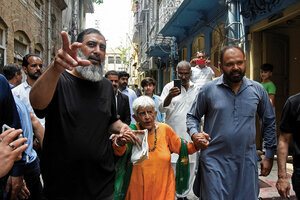Why my Hindi was a bit strange

Reena Varma, an Indian citizen born in Pakistan, visits her ancestral home after 75 years, in Rawalpindi, Pakistan, July 20.
Waseem Khan/Reuters
During my stint in India for the Monitor, there was always a place at the kitchen table for Harilal. He was my Hindi teacher, and my wife and I still smile when we trade stories about him – ever gracious, always passionate about language, and delighted by my then-1-year-old daughter.
But the Hindi he taught was a little different. When we used it to hire a tuk-tuk or order a kebab in Delhi, we’d get strange looks. Your Hindi is too formal, they’d always say. It was a mystery. Why was he teaching us seemingly outdated Hindi?
The mystery was solved on my first trip to Pakistan. There, the cabdriver turned to me with an astonished expression and exclaimed, “Your Urdu is excellent!”
Harilal, after all, was born in what is now Pakistan and came to India during partition, when one country was ripped in two along religious lines. My mystery was just one tiny example of how entwined the two counties are, linguistically, historically, and socially – and how traumatic the separation was, displacing more than 10 million people.
Partition happened 75 years ago, and I thought back to Harilal as I read one of the many remembrances being published about partition this summer. The NPR report told of Ishar Das Arora, who, like Harilal, had left his birthplace in Pakistan for India as a boy and never returned.
Mr. Das Arora’s grandson managed to get into Pakistan, and with a map scribbled from his grandfather’s memory, he found the village and recorded his discoveries in a 3D video format. So earlier this year, Mr. Das Arora went back to his hometown virtually – seeing the houses in the old Hindu section and even the grandson of someone who helped his family escape 75 years ago.
“My school is still there,” he said. “And the hills where my voice used to echo.”
I can imagine the expression on Mr. Das Arora’s face when he took off the goggles after his virtual tour, because I saw hints of the same expression in Harilal’s eyes years ago. Talk of home always brought a twinkle of memory, a tug of a belonging that even partition could not break. Now I can imagine a young Harilal sitting in the green hills of Pakistan, perhaps listening to his own echo as Mr. Das Arora did.
Historian Aanchal Malhotra wrote, “I have grown up listening to my grandparents’ stories about ‘the other side’ of the border. But, as a child, this other side didn’t quite register as Pakistan, or not-India, but rather as some mythic land devoid of geographic borders, ethnicity and nationality.”
In those stories, it was “a land with mango orchards, joint families, village settlements, endless lengths of ancestral fields extending into the horizon, and quaint local bazaars teeming with excitement on festive days ... a very idyllic, somewhat rural, version of happiness.”
This happiness was Harilal’s gift to me, too: Hindi lessons that made the subcontinent’s deepest division feel a bit smaller.

